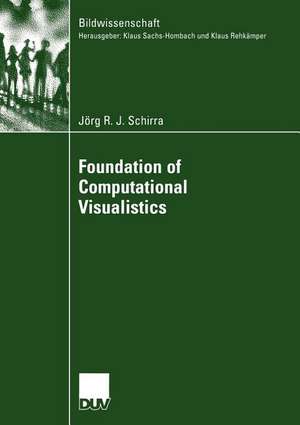Foundation of Computational Visualistics: Bildwissenschaft, cartea 14
Autor Jörg R. J. Schirraen Limba Engleză Paperback – 25 noi 2005
Preț: 330.90 lei
Preț vechi: 413.62 lei
-20% Nou
Puncte Express: 496
Preț estimativ în valută:
63.32€ • 67.71$ • 52.79£
63.32€ • 67.71$ • 52.79£
Carte tipărită la comandă
Livrare economică 17 aprilie-01 mai
Preluare comenzi: 021 569.72.76
Specificații
ISBN-13: 9783835060159
ISBN-10: 3835060155
Pagini: 314
Ilustrații: XVI, 294 p. 96 illus.
Dimensiuni: 148 x 210 x 20 mm
Greutate: 0.38 kg
Ediția:2005
Editura: Deutscher Universitätsverlag
Colecția Deutscher Universitätsverlag
Seria Bildwissenschaft
Locul publicării:Wiesbaden, Germany
ISBN-10: 3835060155
Pagini: 314
Ilustrații: XVI, 294 p. 96 illus.
Dimensiuni: 148 x 210 x 20 mm
Greutate: 0.38 kg
Ediția:2005
Editura: Deutscher Universitätsverlag
Colecția Deutscher Universitätsverlag
Seria Bildwissenschaft
Locul publicării:Wiesbaden, Germany
Public țintă
ResearchCuprins
Table of Content.- 1 Images in Computer Science: Clarifications Required.- 1.1 The Age of the Images.- 1.2 Toward Information Society.- 1.3 Images and Computers: The Digital Picture.- 1.4 Requirements for a Modem Computer Scientist.- 1.5 Determining the Goal.- 2 Computational Visualistics: Seen from its Roots.- 2.1 Computer Science: Subject and Methodology.- 2.2 Visualistics and the Many Sciences of Pictures / Images.- 2.3 Computational Visualistics and the Data Type »Image«.- 3 Preliminary Clarifications from Visualistics.- 3.1 Pictures on the Border: Overlooking a Wide Kingdom.- 3.2 A Synthetic Proposal: Images as “Perceptoid” Signs.- 3.3 Image and Object.- 3.4 Image and Language.- 3.5 Image and Image User.- 3.5.5 Reflective Communication & Pictures of Art.- 3.6 Conclusions for Computational Visualistics.- 4 The Generic Data Type »Image«: General Aspects.- 4.1 The Organizational Principle of the Discussion.- 4.2 Syntactic Aspects.- 4.3 Semantic Aspects.- 4.4 Pragmatic Aspects.- 5 Case Studies: Using the Data Type »Image«.- 5.1 Semantic Requests to Image Databases in IRIS.- 5.2 Rhetorically Enriched Pictures.- 5.3 A Border Line Case: Immersion.- 5.4 Another Border Line Case: Mental Images.- 6 Conclusions - Perspectives.- 6.1 The Foundation of Computational Visualistics.- 6.2 The Components of the Data Structure »Image«.- 6.3 The Future of an Institutional Computational Visualistics.- Appendices.- A Notes.- B References.- C List of Figures.- D List of Table.- E Name Index.- F Subject Index.
Notă biografică
PD Dr. Jörg R. J. Schirra studierte Informatik, Physik, Philosophie und Psychologie an der Universität des Saarlandes. Nach einem längeren Forschungsaufenthalt in Berkeley habilitierte er sich an der Fakultät für Informatik der Universität Magdeburg.
Textul de pe ultima copertă
A few years ago, the department of computer science of the University of Magdeburg developed a completely new diploma programme called 'computational visualistics', a curriculum dealing with all aspects of computational pictures. So far, only isolated aspects had been studied in computer science, particularly in the independent domains of computer graphics, image processing, information visualization, and computer vision. Is there indeed a coherent domain of research behind such a curriculum? The answer depends on a data structure that acts as a mediator between general visualistics and computer science: the data structure "image".
Jörg R. J. Schirra investigates that data structure, its components, and its application conditions, and elaborates the very foundations of computational visualistics as a unique and homogeneous field of research. Before concentrating on the data structure, the author closely examines the theory of pictures in general and the definition of pictures as perceptoid signs in particular. He includes an act-theoretic consideration of resemblance as the crucial link between image and object, the communicative function of context building as the central concept for comparing pictures and language, and several modes of reflection underlying the relation between image and image user.
Jörg R. J. Schirra investigates that data structure, its components, and its application conditions, and elaborates the very foundations of computational visualistics as a unique and homogeneous field of research. Before concentrating on the data structure, the author closely examines the theory of pictures in general and the definition of pictures as perceptoid signs in particular. He includes an act-theoretic consideration of resemblance as the crucial link between image and object, the communicative function of context building as the central concept for comparing pictures and language, and several modes of reflection underlying the relation between image and image user.


























